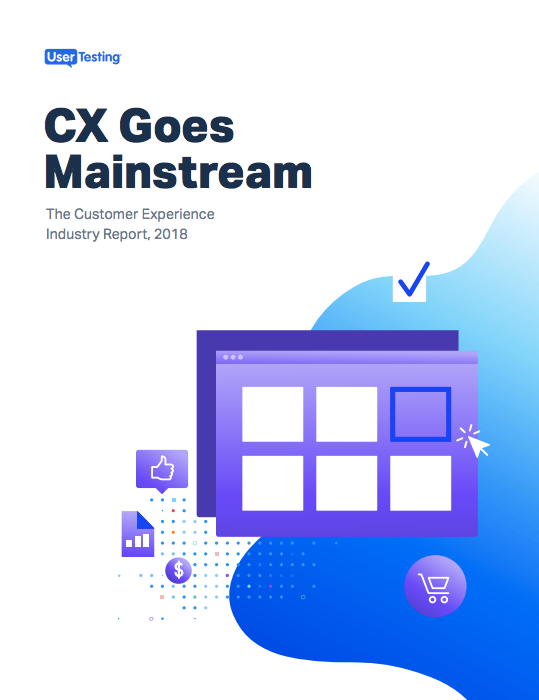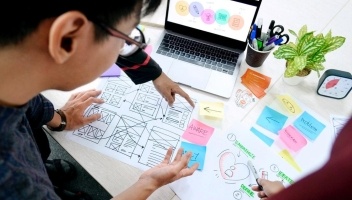
In our recent Customer Experience (CX) Industry Report, we learned that at UserTesting we are not alone in believing that we share responsibility across the organization on providing our customers with a great experience. Almost 40% of respondents said that everyone is responsible for the overall customer experience, highlighting the opportunity for companies to embrace the democratization of CX research.
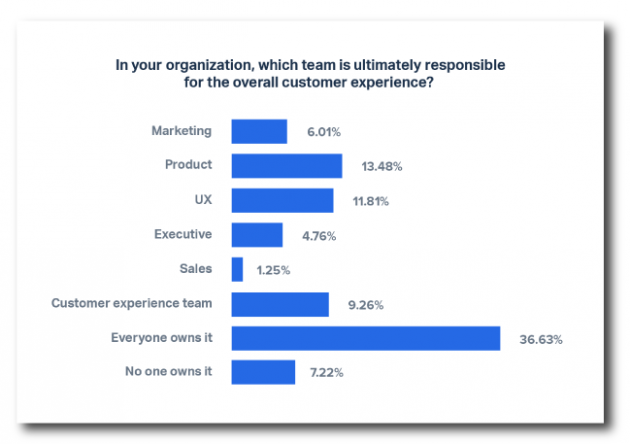
One of the main ways this manifests itself at UserTesting is that we all believe we can make better, more confident decisions with human insights, no matter what our job title is—but that's easier said than done.
How do you empower non-researchers to do research? It helps to have a research team that can develop programs. Our Product Insights team was formed a year ago. Although we spend a lot of time working closely embedded on Product teams throughout the development process, we can’t help everyone with every project—nor do we want to.
Just like the CX Industry Report survey respondents—over 90% of whom want to empower employees to do research—we want to enable more people across all disciplines in an organization conduct customer experience research.
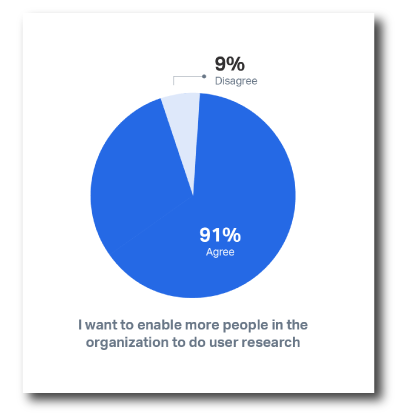
We’re also lucky that we work with Product Managers, Designers, and Marketers who want to be close to our customers. They don’t want to submit a request to our research team and get a report back weeks later. They want to hear directly from customers themselves. This is why we’ve created different support systems to help our colleagues:
- Know which research method to use
- Access existing data
- Recruit participants
- Get feedback
- Analyze the results
The following is a case study about how we empowered our Design Team to #EmbraceHumanInsights.
As part of our redesign, our Design Team has been focused on developing a Design System, a collection of UI elements, patterns, and standards to unify our UX and speed up new design work. The Lead Designer has learned to validate all new patterns in our Design System with the help from our Product Insights Team. Seeing the results from the prototype firsthand, the Designer was hooked and couldn't wait to run more studies.
1:1 Training
We knew going into this project that it would be an iterative and ongoing process, so we used that to our advantage. We also knew that this Designer would mostly be conducting usability testing on static images or lightweight clickable prototypes. The general structure of the study—goals, participants, and tasks—would be really similar each time.
We decided to take the approach of pairing a UX Researcher with a Designer, having them work super closely together on the first few projects, and then slowly transitioning more and more of the work from the Researcher to the Designer.
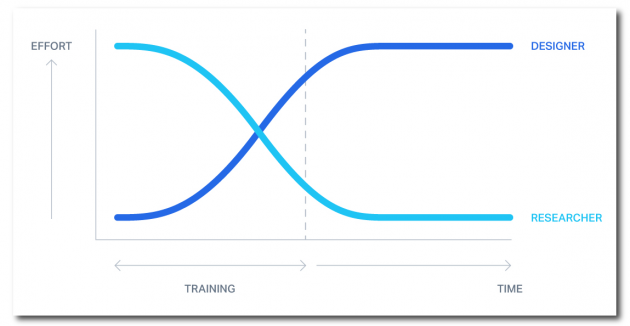
Initially, the Researcher spends more effort, but as the designer learns how easy it is to get user feedback on every new design he gradually takes over and does the bulk of the work himself.
The Researcher created a test plan template that was filled out together with the Designer:
- What are you hoping to learn? (Example: “Is it clear that “...” leads to more options and is it a good replacement to “Action dropdown”?)
- Who do we want feedback from? (Example: Existing active users and new users who’ve never used UserTesting before.)
Based on this info, the Researcher filled out the test plan with specific Screeners, Tasks, and Questions. This test plan forms the basis for all future studies and is updated and tweaked based on the focus of the study.
For the first few studies, the Researcher recruited participants, conducted the sessions, and discussed the results, but made sure to invite the Designer to every session. As the Designer gets the hang of how to be a good moderator, he starts to take over some of the sessions. During the training period, the Researcher stays close to the analysis the longest. This knowledge transfer is crucial, as they’d write their own summaries and then present them to each other. Knowing how to make sense of everything you’ve heard and seen, and making decisions based on that, is the hardest part of conducting customer experience research.
Keep in mind that these were quick and dirty usability studies, with typically 2-3 participants each round, and very focused goals. There were lots of opportunities for the Designer to learn how to do this himself. They got really good at testing specific components and flows. This type of research lends itself especially well to unmoderated testing as well. The template originally created was also set up as a template in UserTesting so that the Designer could launch a new study whenever he needed to. (This is similar to the templates we’ve created for use by our customers in UserTesting).
Fun fact: when we do research on our own product, using our panel, we typically whitelabel the design and remove all references to “UserTesting”.
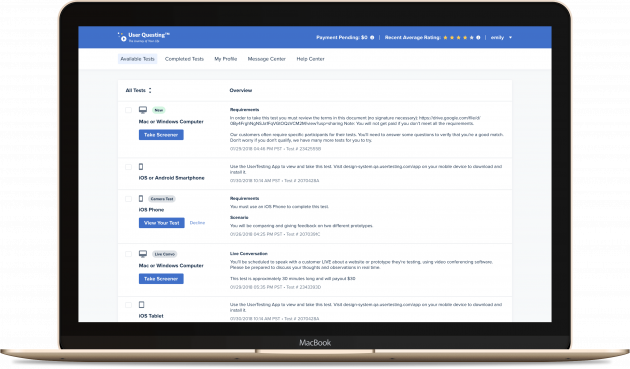
The current balance we’ve found
The “training” took 4-5 hours per week of a Researcher’s time for two months. We’ve now settled into a partnership model towards the right of the graph above. The Researcher maybe spends an hour total every month working with the Designer.
What Design does themselves:
- Repurpose previous test plan
- Conduct or launch sessions
- Make decisions based on findings
What Research helps with:
- Choose methodology (if not the typical prototype test)
- Review test plan (if new)
- Recruitment (if not from our panel)
- Debrief on session and discussion of findings (when requested)
It’s worth the extra effort up front
Our Design System is such a central part of our product that it’s essential it works well. The whole point of the design system is that it can be reused, so we want to make sure the patterns work well for our users. By giving our Researchers time to train others at the company, we reap the benefits in the long term. Now we don’t add any new patterns or updates before testing it, without the need for each new pattern to go through Product Insights.
One-on-one training isn’t the only way we empower non-researchers at UserTesting. On both the data science and UX Research side, we’ve created a checklist with links to templates and examples that can be used as starting points. An essential component to our success at UserTesting is to make sure that everyone on the Product Insights team has time in their week to help others conduct their own research—rather than getting overloaded doing the research themselves.
Want to learn more?
If you’d like to learn more about how UserTesting can help you understand your customers through real-time human insights, contact us at support@usertesting.com.
Download the full report
Get the results of the 2018 Customer Experience Industry Report and find out how your organization measures up.
Marieke is the founder and leader of UserTesing’s Product Insights Team, overseeing the company’s Data Science and UX Research efforts. She's spent over 10 years helping companies grow through human-centered design. Formerly a consultant at Nielsen Norman Group, she’s trained thousands of professionals on the value of gaining a deep customer understanding.
